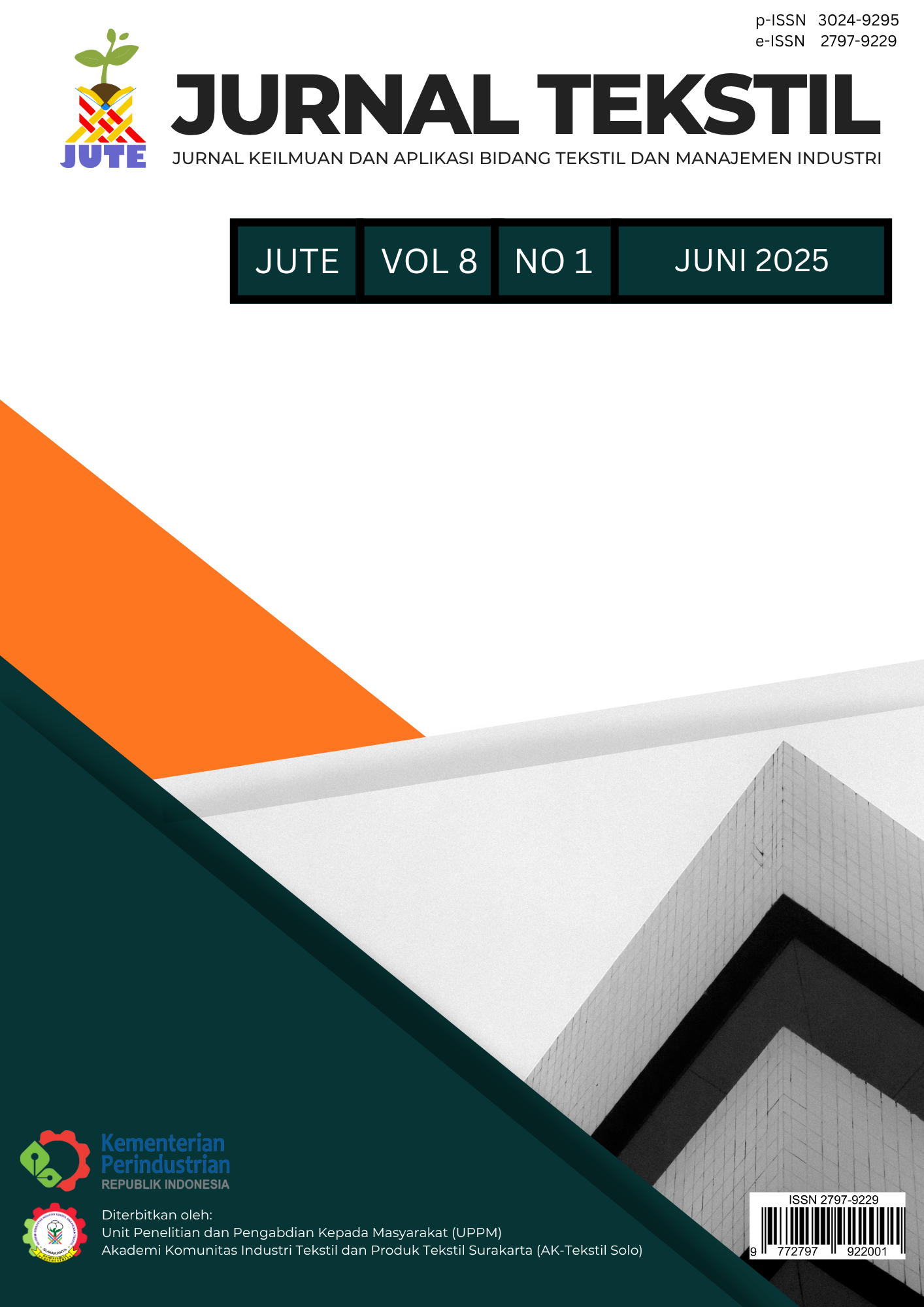Pendekatan Kuantitatif Terhadap Peningkatan Kualitas Sliver melalui Intervensi Pembersihan Top Roll Pada Mesin Drawing
Main Article Content
Abstract
Penelitian ini bertujuan mengevaluasi efektivitas penggunaan alkohol teknis 70% dalam menurunkan nilai unevenness (U%) sliver sebagai indikator mutu produk semi jadi dalam industri tekstil. Melalui pendekatan kuantitatif pre-post design di lingkungan produksi nyata PT XYXY, Tbk, nilai U% diukur sebelum dan sesudah intervensi pembersihan top roll. Hasil menunjukkan penurunan signifikan nilai U% dari 1,97% menjadi 1,88% (p < 0,001) dengan ukuran efek besar (Cohen’s d = 2,07). Selain itu, analisis Fishbone Diagram mengidentifikasi lima faktor utama penyebab lapping: mesin, material, metode kerja, lingkungan, dan manusia. Temuan ini menegaskan bahwa intervensi sederhana dapat memberikan dampak signifikan secara teknis dan praktis, namun belum cukup untuk memenuhi standar mutu internal. Implikasi praktis mencakup adopsi prosedur pembersihan standar, pelatihan rutin operator, serta pengembangan protokol perawatan terpadu berbasis data. Studi ini merekomendasikan evaluasi lanjutan terhadap umur pakai komponen serta eksplorasi pelarut alternatif yang lebih berkelanjutan.
Downloads
Article Details

This work is licensed under a Creative Commons Attribution-ShareAlike 4.0 International License.
Copyright (c)
References
Akyaz, T., & Engın, D. (2024). Machine Learning-Based Predictive Maintenance System for Artificial Yarn Machines. IEEE Access, 12, 125446–125461. https://doi.org/10.1109/ACCESS.2024.3454548
Ali, S., Rasul, A., Shah, P. A., Al-Rawi, M. B., & Naseem, M. (2024). Green synthesis of antipathogenic particles by utilizing the citrus plant waste and their application in medicated fabrics. Journal of Industrial Textiles, 54. https://doi.org/10.1177/15280837241275203
Bainbridge, A. (2023). Material-Based Treatments. Conservation of Books, 554–640. https://doi.org/10.4324/9781003162674-30
Behera, P., Aravind, S., & Seetharaman, B. (2024). Honeydew contaminated cotton: a sticky problem needs a solution. Research Journal of Textile and Apparel, 28(4), 507–527. https://doi.org/10.1108/RJTA-05-2022-0053
Bhowmick, A., Hall, M., & Benarey, H. A. (2018). Rubber Products Manufacturing Technology. Rubber Products Manufacturing Technology. https://doi.org/10.1201/9780203740378
Bremen Cotton Exchange. (2021). 35th International Cotton Conference Bremen, DEVirtual Event, 17.03. – Premiere for the hybrid edition. https://etn-net.org/berichte/35th-international-cotton-conference-bremen-devirtual-event-17-03-18-03-2021.html
Chang, R.-I., Lee, C.-Y., & Hung, Y.-H. (2021). Cloud-Based Analytics Module for Predictive Maintenance of the Textile Manufacturing Process. Applied Sciences, 11(21), 9945. https://doi.org/10.3390/app11219945
Choudhury, A. K. R. (2017). Fabric Dyeing and Printing. Textile and Clothing Design Technology, 281–332. https://doi.org/10.1201/9781315156163-11/FABRIC-DYEING-PRINTING-ASIM-KUMAR-ROY-CHOUDHURY
Eco-Nova. (2023). Cleaning rollers in industry. https://www.eco-nova.de/en/sichere-walzenreinigung-ohne-aceton/
Goldsworthy, K., Harris, K., Hassan, J. M., & Solomon, M. (2022). Catalyst Report on Circular Fashion and Textiles-The Provision of Research Relating to Environmental Science for Circular Fashion and Textiles.
Grau, J., Azorín, C., Benedé, J. L., Chisvert, A., & Salvador, A. (2022). Use of green alternative solvents in dispersive liquid-liquid microextraction: A review. Journal of Separation Science, 45(1), 210–222. https://doi.org/10.1002/JSSC.202100609,
Harianto, D., Pujianto, H., Bintang, H. S., & Alfanti, D. (2025). Analisa Perbaikan Benang Kusut Akibat Ring Touch Pada Proses Penggulungan Di Mesin Ring Spinning Frame. JISI: Jurnal Integrasi Sistem Industri, 12(1), 67–78. https://doi.org/10.24853/JISI.12.1.67-78
Harianto, D., Sugiyarto, S., & Azizah, R. N. (2024). Perbandingan Kinerja Yarn Guide tipe Pig tail dan Snail Wire dalam Kualitas Hairiness Benang Ring Spinning Frame. Jurnal Tekstil: Jurnal Keilmuan dan Aplikasi Bidang Tekstil dan Manajemen Industri, 7(2), 111–119.
Hossain, Md. A., & Samanta, A. K. (2019). Uster analysis of cotton/polyester blended spun yarns with different counts. Journal of Textile Engineering & Fashion Technology, 5(4). https://doi.org/10.15406/jteft.2019.05.00204
Islam, M. T., & Rashid, A. R. M. H. (2020). Optimization of the Critical Production Process in a Textile Factory using AHP.
Islam, Z. (2019). Comparing Quality Parameters of Yarn Produced by Ring, Rotor, and Compact Spinning System. European Scientific Journal ESJ, 15(3). https://doi.org/10.19044/esj.2019.v15n3p461
Karakan Günaydın, G. (2022). Effect of selected production parameters on yarn evenness, imperfections and tensile properties of core spun vortex yarns. International Journal of Clothing Science and Technology, 34(6), 829–851. https://doi.org/10.1108/IJCST-08-2021-0116
Malleval, J.-V. (2022). Clean production processes for the textile industry.
Mohd Rusli, N. W. (2019). Effects of kenaf/polyester blending ratios on physical and mechanical properties of yarns produced from ring spinning system.
Musyoki, J. K. (2019). Improvement Of Ring Frame Spindle Utilization In Short Staple Spinning: A Case Study Of A Cotton Spinning Mill.
Patil, H., & Athalye, A. (2024). Sustainable scouring of cotton using extracts from wood ash and soapnut and its optimisation by response surface methodology. Coloration Technology. https://doi.org/10.1111/COTE.12776
Pucciarelli, M. (2023). Life Cycle Thinking for the sustainability assessment of nanoparticles’ manufacturing and applications.
Rahman, M. M., Mashud, M., & Rahman, M. M. (2023). Advanced Technology in Textiles: Fibre to Apparel. Dalam Textile Science and Clothing Technology. Springer Nature Singapore. https://books.google.co.id/books?id=ys7FEAAAQBAJ
Riglet, L., Nicol, F., Leonard, A., Eby, N., Claquesin, L., Orliac, B., Ornetti, P., Laroche, D., & Gueugnon, M. (2023). The Use of Embedded IMU Insoles to Assess Gait Parameters: A Validation and Test-Retest Reliability Study. Sensors, 23(19), 8155. https://doi.org/10.3390/S23198155/S1
Tesema, G. B. (2024). Cotton Quality Requirements for Spinning. 241–284. https://doi.org/10.1007/978-981-99-9149-5_10
Uyanto, S. S. (2022). An Extensive Comparisons of 50 Univariate Goodness-of-fit Tests for Normality. Austrian Journal of Statistics, 51(3), 45–97. https://doi.org/10.17713/AJS.V51I3.1279
Yang, Y., Zhang, M., Ju, Z., Tam, P. Y., Hua, T., Younas, M. W., Kamrul, H., & Hu, H. (2021). Poly(lactic acid) fibers, yarns and fabrics: Manufacturing, properties and applications. Textile Research Journal, 91(13–14), 1641–1669. https://doi.org/10.1177/0040517520984101
Yulianto, B. (2020). Analisis tentang Setting Roller Gauge dan Break Draft Tidak Merubah Total Draft pada Mesin Roving Rieter type F10 / 55011- 00425 Tahun Pembuatan 1998. Jurnal Tekstil: Jurnal Keilmuan dan Aplikasi Bidang Tekstil dan Manajemen Industri, 3(1), 26–35. https://doi.org/10.59432/jute.v3i1.8

